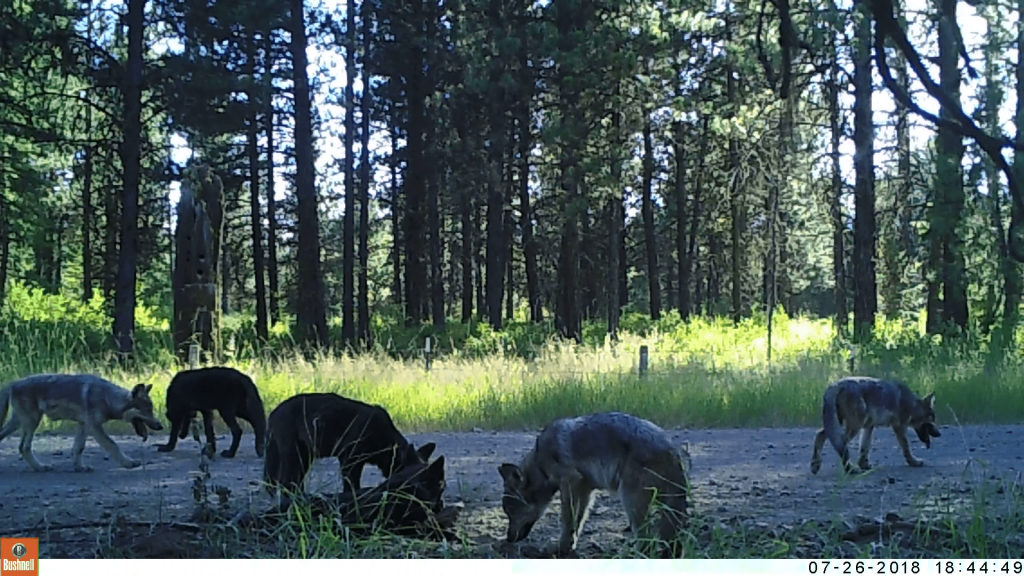
WDFW Commission Denies Petition To Codify Wolf-Livestock Protocols
Pointing to the need for flexibility, the Washington Fish and Wildlife Commission this morning unanimously denied a petition to require nonlethal tactics be used to reduce wolf-livestock conflicts.
Hardcore out-of-state wolf advocates wanted “to place enforceable constraints on when, where and how lethal removal may occur” by codifying preventative measures, but members of the citizen panel rejected that approach as too shackling.

As it stands, removals are guided by protocols developed in 2017 with WDFW’s Wolf Advisory Group stakeholders, instate representatives of the livestock, hunting and conservation worlds.
They stress preventing conflict through range riding, delayed turnout, moving sick or dead cattle off the range and other measures first but allow for agency director Kelly Susewind to consider taking out wolves in packs that commit three rapid-fire depredations or chronically kill cattle, sheep or other domestic animals over a 10-month window in an effort to head off further losses for both herds and packs.


In one recent case in Northeast Washington this spring, Susewind has not gone lethal yet, while in another on the other side of a troubled mountain range he authorized taking out up to two late last week.
In moving to reject the proposed rulemaking, Commissioner Kim Thorburn, the Spokane birder, said that just like you can’t always keep deer out of your garden or raccoons out of the chicken coop, so it goes with wolves and livestock.
She said working on a case by case basis was a better approach and that rules “take away flexibility.”
Commissioners Bob Kehoe and Dave Graybill, who come from commercial and recreational fishing backgrounds, suggested the petitioners’ box-checking approach could backfire on them.



The request came from the Center for Biological Diversity of Arizona, Cascadia Wildlands of Eugene, Western Watersheds Project of Idaho’s Sun Valley region and WildEarth Guardians of New Mexico.
They and others have been working on multiple fronts to pick away at how wolves are managed in Washington, including lawsuits in state superior and US District courts, and imploring Governor Inslee to step into wolf management.
Much of their stated ire centers around the Diamond M Ranch of northern Stevens County, which grazes on Forest Service allotments there and in Ferry County. They say WDFW has removed 26 wolves on behalf of the operation, which they claim has a history of failing to use enough preventative measures.
CBD’s instate rep Sophia Ressler told the Capital Press that if the Fish and Wildlife Commission denied the petition, they would probably again go to the governor, who last September sent WDFW a letter to stress nonlethal wolf management in the Kettle Range.
Scott Nielsen, a Stevens County rancher, told the ag-world news outlet, that producers wanted to know the rules, but said, “They keep changing … We don’t them to be written by environmental groups or the governor, but we want the department to be consistent.”
While it just makes sense to prevent conflict, even when multiple measures are taken wolf attacks can still occur, as appears to be the case with the Leadpoint Pack. It injured four calves in mid-June, despite the rancher “calving away from areas occupied by wolves, (delaying) turnout of calves (to coincide with deer fawns, and elk and moose calves becoming available as prey), removing sick/injured livestock from the pasture, carcass sanitation, allowing steers to heal after castration, human presence around livestock, and using Cattle Producers of Washington (CPoW) range riders.”


Other commissioners on this morning’s petition call included Chair Larry Carpenter, Vice Chair Barbara Baker and members Brad Smith and Don McIsaac.
In their recommendation that the petition be rejected, WDFW staffers stated:
- Determining the need to use lethal control to stop repeated depredations is a complicated issue.
- Limiting the flexibility articulated in the Wolf Conservation and Management Plan reduces the ability to address each case-specific wolf-livestock conflict.
- Proposed rule language as written has problems.
- This issue of wolf management and removals involves internal department actions, and internal practices are not legally required to be set out in rule, nor is it normal to set the same out in rule.
- The Department’s WAG process involves significantly more public and community involvement and interaction than would occur through a single rulemaking hearing.
- If the proposed rule was adopted, WDFW would need to hire a significant number of additional Wildlife Conflict Specialists. This is not feasible given the State’s current budgetary uncertainty.

Late this morning, the agency announced the beginning of weekly staff furloughs starting Monday in response to Covid-19-related budget shortfalls.
Wolves are federally recovered in Northeast Washington and elsewhere in the eastern third of the state, providing WDFW with the ability to remove pack members and even packs in worst-case scenarios.
Since 2012, a total of 31 have been killed by the agency, a handful of others by ranchers who’ve caught wolves in the act of attacking their stock.
